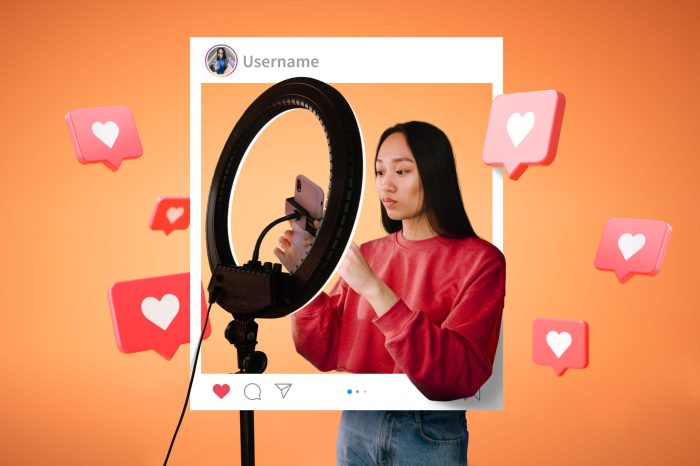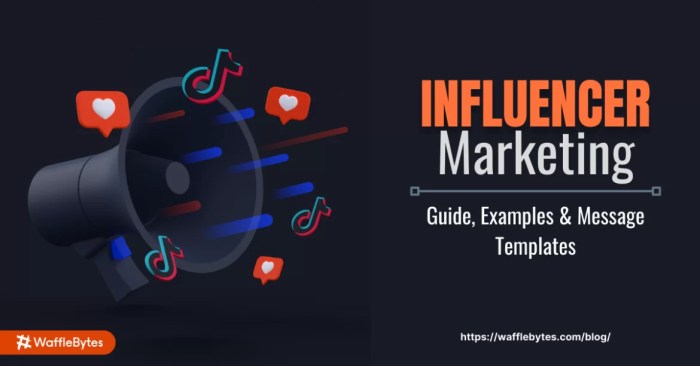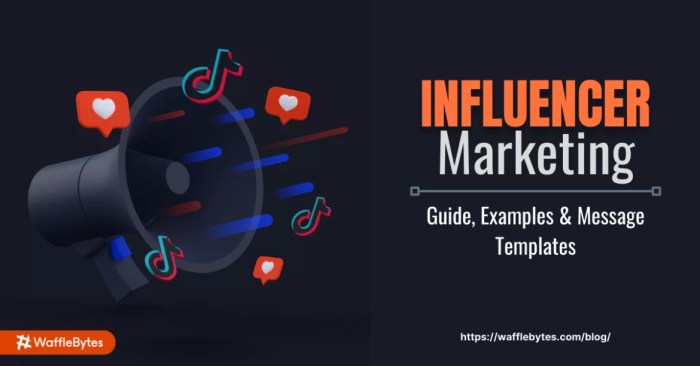Influencer Marketing Guide, your go-to source for navigating the world of social media influencers and maximizing brand exposure. From nano to mega influencers, we’ve got you covered with tips, examples, and strategies to level up your marketing game.
Introduction to Influencer Marketing

Influencer marketing has become a vital strategy in the digital age, leveraging the influence of popular individuals to promote products and services to a larger audience. Unlike traditional marketing methods, influencer marketing focuses on building authentic connections with consumers through trusted influencers who have a loyal following. This form of marketing allows brands to reach a specific target audience in a more personalized and engaging way.
Significance of Influencer Marketing
- Enhanced Credibility: Influencers can provide authentic recommendations that resonate with their followers, building trust and credibility for the brand.
- Increased Reach: Leveraging influencers with a large following allows brands to reach a broader audience and increase brand awareness.
- Targeted Marketing: Influencers can help brands target specific demographics or niche markets more effectively than traditional advertising methods.
Differences from Traditional Marketing
- Personalized Approach: Influencer marketing focuses on creating genuine connections with consumers through relatable content, rather than pushing sales messages.
- Consumer Engagement: Influencer marketing encourages two-way communication between brands and consumers, fostering a sense of community and engagement.
- Measurable Results: Influencer marketing allows brands to track the performance of campaigns more accurately, with data-driven insights on reach, engagement, and conversion rates.
Examples of Successful Influencer Marketing Campaigns
1. Daniel Wellington’s collaboration with micro-influencers on Instagram, showcasing their watches in lifestyle photos, leading to a surge in sales and brand visibility.
2. Gymshark’s partnership with fitness influencers to promote their activewear, driving significant online sales and brand loyalty among fitness enthusiasts.
3. Fashion Nova’s use of celebrity influencers like Cardi B to launch exclusive clothing collections, resulting in sold-out items and increased social media buzz.
Types of Influencers
Influencer marketing relies on different categories of influencers, each with its own set of advantages and disadvantages. Understanding the distinctions between nano, micro, macro, and mega influencers can help brands make informed decisions when planning their marketing strategies.
Nano Influencers
Nano influencers typically have a smaller following, ranging from 1,000 to 10,000 followers. While they may not have a massive reach, they often have highly engaged audiences that trust their recommendations. Collaborating with nano influencers can lead to more authentic and genuine connections with consumers.
Micro Influencers
Micro influencers have a slightly larger following, usually between 10,000 to 100,000 followers. They offer a balance between reach and engagement, making them ideal for niche markets. Working with micro influencers can help brands target specific demographics effectively.
Macro Influencers
Macro influencers have a substantial following, typically ranging from 100,000 to 1 million followers. They have a broad reach and can help brands increase visibility and awareness quickly. However, working with macro influencers can be costly, and their content may not always resonate as authentically with audiences.
Mega Influencers
Mega influencers are household names with millions of followers. They have immense reach and can significantly impact brand awareness. Collaborating with mega influencers can elevate a brand’s status but comes with a high price tag and potential risks if the partnership does not align with the influencer’s image or values.
Finding the Right Influencers
Finding the right influencers for your brand is crucial to the success of your influencer marketing campaign. Identifying influencers that align with your brand values and target audience can significantly impact the effectiveness of your collaborations.
Identifying the Right Influencers
When looking for influencers, consider factors such as their niche, content style, engagement rate, and audience demographics. Look for influencers whose values and voice resonate with your brand’s identity to ensure authenticity in your partnerships.
- Utilize social media listening tools to identify influencers who are already engaging with your brand or industry.
- Look for influencers who have a genuine interest in your products or services, rather than just those with a large following.
- Consider micro-influencers who may have a smaller reach but higher engagement rates with their audience.
Tools and Platforms for Finding Influencers
There are various tools and platforms available to help brands find and vet influencers for their campaigns.
- Platforms like Influencer Marketing Hub, Upfluence, and AspireIQ provide databases of influencers across different niches and social media platforms.
- Social media analytics tools like Hootsuite and Sprout Social can help track influencer performance and audience demographics.
- Consider using influencer marketing agencies to connect with relevant influencers and streamline the partnership process.
Reaching Out and Establishing Partnerships
When reaching out to influencers, it’s essential to personalize your communication and clearly Artikel the benefits of collaborating with your brand.
- Send personalized emails or direct messages that showcase your understanding of the influencer’s content and audience.
- Clearly define the terms of the partnership, including compensation, deliverables, and timeline.
- Nurture relationships with influencers by engaging with their content and showing appreciation for their work.
Collaborating with Influencers
When it comes to collaborating with influencers, there are key elements that are crucial for a successful influencer marketing campaign. From negotiation strategies to creating authentic content, these factors play a significant role in the outcome of your partnership.
Key Elements of a Successful Influencer Marketing Campaign
- Identifying clear campaign objectives and goals.
- Selecting the right influencers that align with your brand values and target audience.
- Establishing a mutually beneficial partnership agreement with the influencer.
- Providing creative freedom for the influencer to produce authentic content.
- Measuring and analyzing the campaign’s performance to track ROI and engagement.
Negotiation Strategies for Compensating Influencers
- Offer a fair compensation package based on the influencer’s reach, engagement rates, and expertise.
- Consider providing additional benefits such as exclusive discounts, product samples, or event invitations.
- Negotiate terms and deliverables clearly to avoid misunderstandings later on.
- Build a long-term relationship by valuing the influencer’s work and providing continuous support.
Best Practices for Creating Authentic Content with Influencers
- Encourage influencers to share personal stories or experiences related to your brand.
- Maintain transparency and authenticity in all sponsored content to build trust with the audience.
- Collaborate closely with influencers on content creation to ensure it resonates with their followers.
- Allow room for creativity and experimentation to showcase the influencer’s unique style and voice.
Measuring Influencer Marketing ROI

Influencer marketing can be incredibly beneficial for brands, but measuring the return on investment (ROI) is essential to determine its success. Tracking and analyzing key performance indicators (KPIs) is crucial in assessing the impact of influencer collaborations. Let’s delve into how you can effectively measure the ROI of your influencer marketing campaigns.
Tracking Performance Metrics, Influencer Marketing Guide
- Engagement Rate: Monitor likes, comments, shares, and overall engagement on influencer posts to gauge audience interaction.
- Click-Through Rate (CTR): Measure the percentage of clicks on influencer-generated content that leads to your website or landing page.
- Conversion Rate: Track the number of conversions, such as sales or sign-ups, attributed to influencer campaigns.
Utilizing Analytics Tools
Tools like Google Analytics, Hootsuite, and social media platforms’ native analytics provide valuable insights into campaign performance.
By leveraging these tools, you can track traffic sources, audience demographics, and conversion data to assess the effectiveness of your influencer collaborations.
Calculating ROI
- Cost per Acquisition (CPA): Divide the total cost of the campaign by the number of acquisitions to determine the cost-effectiveness of your influencer marketing efforts.
- Return on Ad Spend (ROAS): Compare the revenue generated from influencer campaigns to the amount spent on them to evaluate the profitability of your investment.
- Lifetime Value (LTV): Analyze the long-term value of customers acquired through influencer marketing to gauge the overall impact on your business.
Influencer Marketing Trends: Influencer Marketing Guide
Influencer marketing is constantly evolving, with new trends shaping the landscape of brand collaborations and social media promotions. Let’s dive into some of the latest trends that are making waves in the industry.
Live Streaming
Live streaming has become increasingly popular among influencers as a way to engage with their audience in real-time. Platforms like Instagram Live, Facebook Live, and Twitch have provided influencers with a unique opportunity to connect with followers on a more personal level.
Virtual Events
In light of the pandemic, virtual events have become a key trend in influencer marketing. From virtual meet-and-greets to online product launches, influencers are finding creative ways to engage with their audience in a digital space.
Long-Term Partnerships
Long-term partnerships between brands and influencers are on the rise, as companies recognize the value of building authentic relationships with content creators. These partnerships often result in more genuine endorsements and higher engagement rates.
Impact of Emerging Social Media Platforms
The emergence of new social media platforms like TikTok and Clubhouse has had a significant impact on influencer marketing strategies. Brands are exploring ways to leverage these platforms to reach new audiences and connect with influencers who have a strong presence on these channels.
Predictions for the Future
Looking ahead, influencer marketing is expected to continue to grow and evolve, with a focus on authenticity, diversity, and sustainability. Brands will need to adapt to changing consumer preferences and stay ahead of the curve to remain relevant in the ever-changing landscape of influencer marketing.
